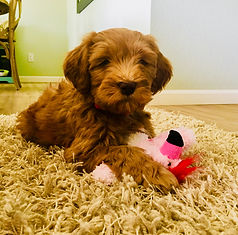


s u n d a n c e l a b r a d o o d l e s
Looking for a non shedding, allergy friendly Australian Labradoodle? You have come to the right place! All of our dogs have therapy dog temperaments!

We breed for excellence, with temperament and superior health being our top priorities!
Training Tips:
NIPPING AND BITING:
Your puppy is teething and has an insatiable desire to chew. You cannot stop this behavior, but you can certainly direct your puppy to chew upon acceptable items until this phase passes (at about a year of age). The only way puppies know how to play is the typical wrestling, biting, chasing, tackling, pulling, and nipping they do with littermates. In the absence of littermates, you and your family suddenly become the littermates. Each and every time your puppy puts its mouth or teeth on your clothes or hands, you immediately need to remove the teeth from the object, firmly close the puppy’s mouth with your hand, and firmly, deeply, and loudly say “NO”. Your puppy will undoubtedly nip/bite at you again. Repeat this same disciplinary action a total of three times in a row. After the third disciplinary action, distract your puppy by giving him/her something he/she can chew upon. Every now and then, a particularly feisty puppy will become more excited by this disciplinary action and need a more distinct disciplinary measure. This next action needs to be initiated quickly. When the first three disciplinary actions don’t seem to work, you can use another technique that may be more successful. Immediately upon your puppy putting his/her mouth on you, put your thumb on the tongue and your other fingers underneath the jaw and press down on the tongue. This will be uncomfortable for your puppy. When behavior meets with uncomfortable consequences, the behavior will stop. Another option is to mix 30% white vinegar and 70% water in a small spray bottle. Spray this in your puppy’s face each time he bites at you. It would benefit your dog greatly to find a playmate that he can play and wrestle about with to get that playful puppy energy out. A tired dog is a good dog and excercise during play is the best form of this for a puppy. The bottom line is that your puppy needs to have active playtime each day. It is your job to find or create activities that are fun for your puppy and that tire him/her out.
BEHAVIOR PROBLEMS:
GROWLING:
Growling - Your puppy may growl at you from time to time as a way to communicate his dislike of something. This is not a sign of aggression unless you allow this to go undisciplined over time. Expressing fear when your puppy growls only teaches him that you back down when you hear a growl. Children should never be allowed to wake a dog when it is asleep or get near a dog when it eats or has a high value item such as a bone. If you have children it is best to be very educated about canines and children together and set rules for yourself.
The most important command you can teach your dog is to leave it. Or trade it. This needs to be taught at a very young age but you can teach it even if your dog is older. IF resource guarding seems to be a problem for your dog then this command would be very helpful! Check out videos on this. A trainer could also teach you how to teach this command.
You need to actively discourage any and all growling directed at you. If your puppy growls at you when you get close to the food bowl, immediately remove the food bowl and feed the puppy out of your hand.
Remember that any behavior you allow as a puppy is then extremely difficult to curb later in life. If you do not wish to have your adult dog on the furniture, do not sit on the sofa holding your puppy. If you do not want your grown dog to grab your pant leg, etc., do not play tug-o-war or other aggressive games with your puppy.
